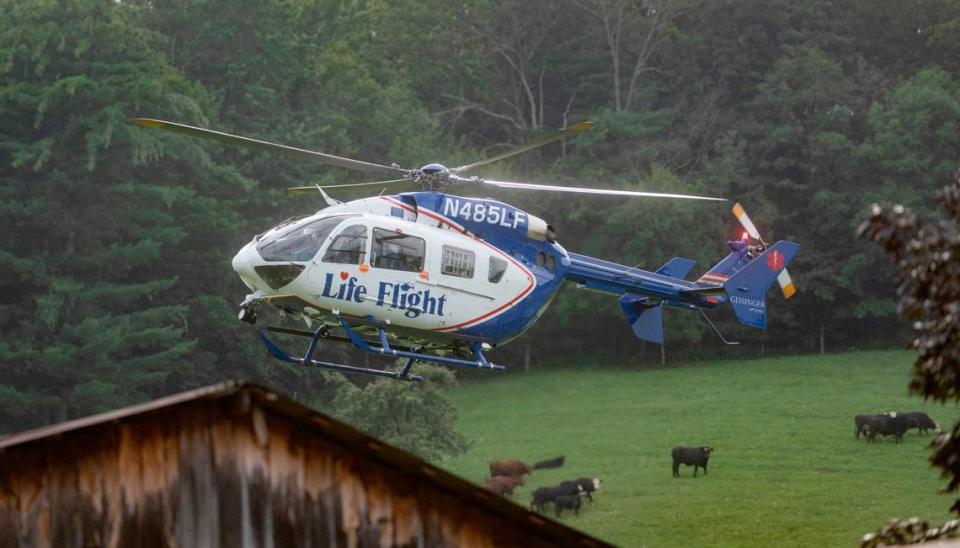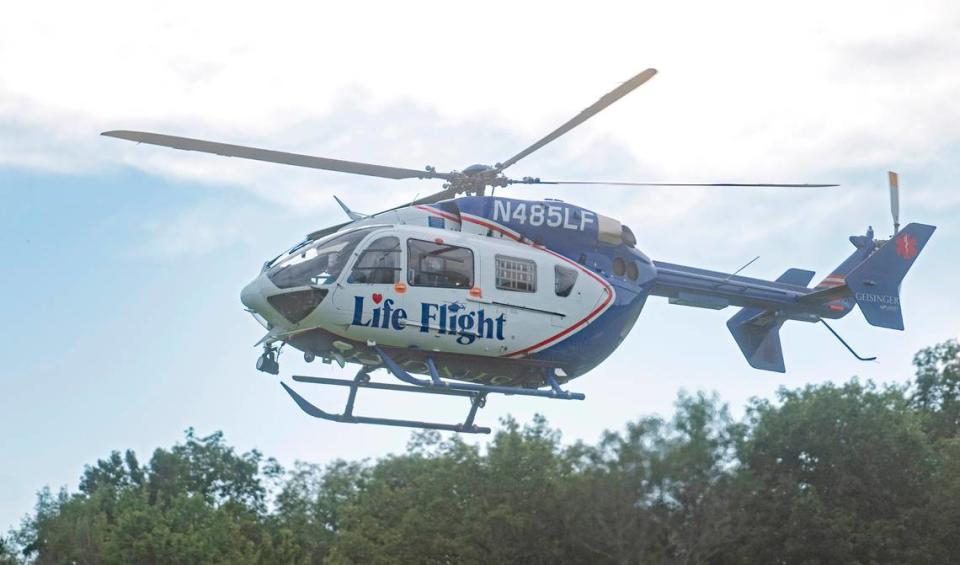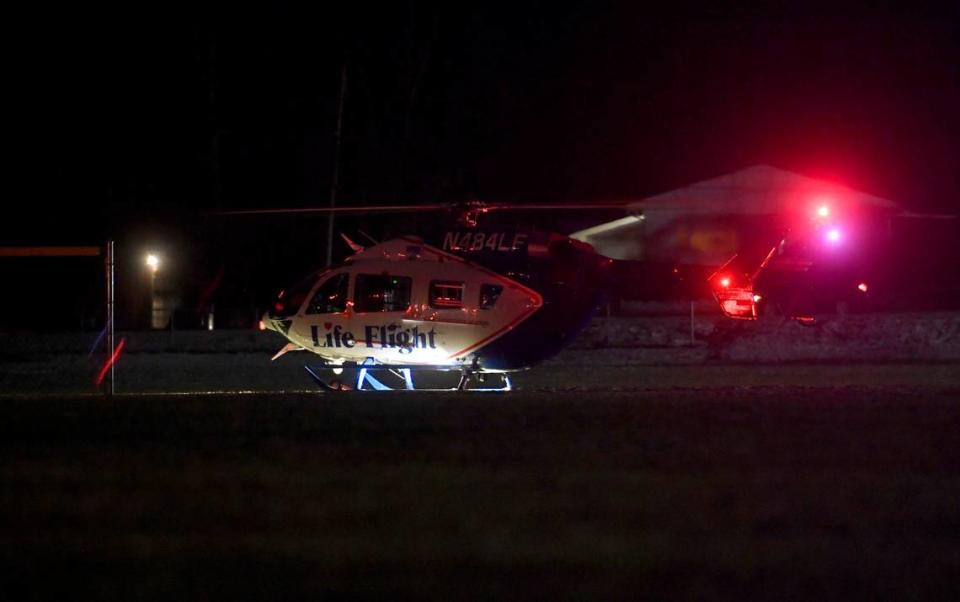Hundreds are flown out of Centre County for traumatic injuries. Can Mount Nittany change that?
Crossing South Atherton Street in State College the evening of Dec. 3, 2019, a car hit Faith Khumalo while she was in the crosswalk.
The Penn State graduate student from Zimbabwe suffered a traumatic brain injury and was airlifted to UPMC Altoona, an accredited trauma center, where she was treated in the ICU. Because of her brain injury, Khumalo said she doesn’t remember the crash or her first three weeks recovering in the hospital.
“One of my doctors basically said it was a miracle. She doesn’t know how I survived,” the 31- year-old said in June from her State College home.
Khumalo is one of the more than 500 people in Centre County flown to outside health facilities each year. But Mount Nittany Health officials are optimistic that could change in the next few years as the hospital pursues a Level IV trauma center accreditation.
Once finalized, Tiffany Cabibbo, executive vice president of patient care services and chief nurse at Mount Nittany Health, said that she thinks that there will be “cases and people” that will be able to stay at the hospital as a result of the accreditation.
“We always, always try to keep care local and keep our patients here. It’s closer to their support systems,” she added.
Cabibbo emphasized that Mount Nittany Health is early in the planning stages, with officials having just made the decision in the fiscal year that began July 1. She declined to provide a cost estimate this early in the process. Other improvement projects are underway at Centre County’s only hospital, including construction for a $350 million addition to the medical center that will allow for all-private rooms.
Cabibbo said that Mount Nittany has yet to submit a letter of intent to the Pennsylvania Trauma Systems Foundation (PTSF), which is the first step in seeking certification. Of the half dozen public officials the Centre Daily Times interviewed for this story, none were initially aware that Mount Nittany Health was planning to pursue accreditation.
“We’re in the beginning process of it, but our intent is to be submitting that letter for this fiscal year. They haven’t received a specific notification, but it doesn’t mean that internal work isn’t already underway,” Cabibbo said.

How far away is a trauma center from State College? One of the farthest distances in PA
What is a trauma center?
A trauma center is a hospital that has the ability to provide specialized care for people suffering from traumatic injuries — often the result of car crashes, falls or other similar accidents. The lowest on the four-pronged scale, Level IV centers can provide “initial care and stabilization of traumatic injuries” before transferring patients to a higher level of care, according to the PTSF website.
“We continue to always look to grow our medical staff. But we do have what we have and we don’t have what we don’t have,” Cabibbo said.
Penn Highlands Dubois in Clearfield County recently received accreditation from the PTSF as a Level II trauma center. The process for Level II accreditation takes four to five years to complete, and hospital officials weren’t able to put an exact price tag on the process.
“No way around it, it’s an expensive proposition and it’s about delivering a service to the community despite the cost, because you care about your community,” said Philip Vuocolo, the facility’s trauma program medical director.
Scott Armen, chief of the Division of Trauma at Penn State Health Milton S. Hershey Medical Center, told the CDT during a June interview that he would “love” to see a trauma center in State College — but that he knows that the process isn’t simple.
“There’s a lot of cost and you have to have the folks who are willing to provide the care. Trauma is a lot of night work, and it’s weekends and holidays,” he said.
The high level trauma centers closest to Centre County are UPMC Altoona (Level II) and Geisinger Danville (Level I), which have the capacity to treat almost any kind of trauma. Geisinger Lewistown is a Level IV center, the same level Mount Nittany Health plans to pursue, and patients are not typically transferred there because of its limitations.
What happens to trauma patients in Centre County now?
Since Centre County does not have its own trauma center, patients that suffer from severe injuries have to be airlifted out of the county, most often by the emergency helicopter service Geisinger Life Flight, which has a contract with Centre County LifeLink.
Which center you’re flown to depends on a number of factors, such as if a given hospital is receiving trauma patients, said Lisa Davis, executive director of the Pennsylvania Office of Rural Health.
“And here’s the other thing. If the ambulance or the Life Flight helicopter is out on a service call, that equipment is not available to respond to any other service call,” added Davis.

Even after a patient gets airlifted, their time with the helicopter provider may not be over. A 2019 report from the Government Accountability Office (GAO) found that the median price charged by airlift providers was around $36,400 for a helicopter transport. If the airlift provider is in-network with a patient’s insurance provider, then the patient won’t receive a bill. But if they aren’t, patients will be charged a balance bill, or the difference between the cost and how much their insurance covers.
Khumalo’s airlift to UPMC Altoona cost around $20,000. Nearly four years after the crash, she said that it would have been “more efficient” to have a trauma center “closer like Mount Nittany.”

According to Geisinger spokesperson Valerie Reed, the flight times from Mount Nittany Medical Center to higher levels of care vary based on distance and weather. To Penn State Hershey Medical Center it’s about 34 minutes, Geisinger Medical Center in Danville is 30 minutes, and the time to UPMC Altoona is 18 minutes. Even if Mount Nittany does successfully complete Level IV accreditation, these times will remain important for some patients, since Level IV centers serve as stabilizing areas for patients before they are transported to a higher level of care.
“Obviously it would be very nice if there was a trauma center nearby, particularly given the fact that we have roughly 33 miles of Interstate 80 that runs through Centre County as well. That is another big driver for a trauma center,” state Rep. Paul Takac, D-College Township, said in late July.
And some areas of the county are much farther away from trauma centers than others. With 58% of Walker Township crashes in 2021 resulting in death or injury, according to Pennsylvania Department of Transportation data, it’s one of the more statistically dangerous locations to crash in the county — and it’s 57.7 miles from UPMC Altoona. But Keith Harter, roadmaster and chairman of the Walker Township board of supervisors, said that that distance hasn’t necessarily been the difference between outcomes.
“A lot of times the biggest time delay isn’t the transportation time via helicopter — it’s extrication from a vehicle,” he told the CDT in a phone interview.
At 31 miles from Geisinger Lewistown, Penn State is the Big Ten school furthest away from a trauma center — and it’s 42 miles away from UPMC Altoona, which is the nearest trauma center that is able to accommodate burns, brain injuries and ICU patients.
“I’ve always been concerned about — on football weekends — the density of people and the number of people there in Beaver Stadium,” said Centre County Commissioner Amber Concepcion. “If there was any kind of emergency we wouldn’t necessarily have adequate health care for a lot of people at once.”
Penn State spokesperson Lisa Powers wrote in an email to the CDT that the University Ambulance Service and Seven Mountains Regional EMS Council have a mass casualty plan ready should such a scenario occur.
“Our No. 1 priority is the safety of our students and our community, and we remain confident that our local healthcare system will provide outstanding care to all that seek treatment for various issues,” she wrote.
What’s next for Centre County?
The Pennsylvania Trauma Systems Foundation is the certifying body for the Commonwealth of Pennsylvania and issues accreditation to hospitals that submit a letter of intent and comply with requirements.
Level IV accreditation, which Mount Nittany Health is seeking, is the lowest level of certification. Cabibbo said that the hospital’s pursuit of accreditation is largely to “formalize” some of the services the hospital already provides.
“We didn’t have to recruit a certain type of doc. We already met the on-call schedules for the doctors. We already have 24-hour lab service. There’s so much part that was already our existing infrastructure,” she said.
But Juliet Altenburg, executive director of PTSF, said the process may not be as simple. While Cabibbo estimated 18-24 months for the accreditation process to be complete, Altenburg said in PTSF’s experience, it’s typically two years at the minimum — sometimes more.
“A lot of hospitals think this is a slam dunk and they equate it with getting stroke certification or cardiac certification,” she said. “And it’s not until they fully understand the standards they have to meet when they realize, ‘oh, this is a lot more work than I thought it would be.’”
A hospital has to submit an additional letter requesting a facility review by July 1 of the year before they want the facility to be reviewed. So if Mount Nittany were to submit a request before July 1, 2024, the earliest the hospital could be accredited would be in 2025. If Mount Nittany was looking to pursue a higher level of accreditation in the future, Altenburg said this could be the first step.
While the plans for Centre County’s first trauma center are in the infancy stages, officials expressed enthusiasm and optimism about what the addition could mean for the community.
“That is excellent news for our region and will add to the invaluable services that Mount Nittany already provides,” State College Mayor Ezra Nanes wrote in an email.

